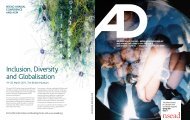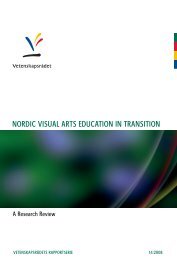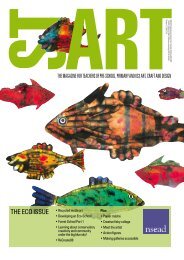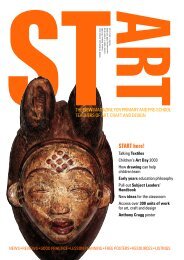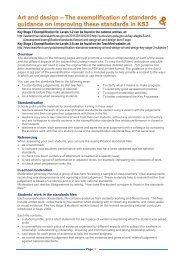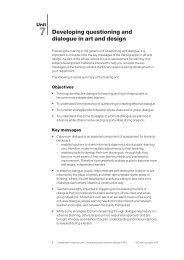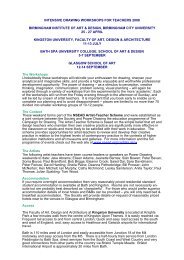Star - The National Society for Education in Art and Design
Star - The National Society for Education in Art and Design
Star - The National Society for Education in Art and Design
Create successful ePaper yourself
Turn your PDF publications into a flip-book with our unique Google optimized e-Paper software.
18<br />
M<strong>in</strong>i poster<br />
h<strong>and</strong>made ceramic elements. <strong>The</strong> children<br />
ga<strong>in</strong>ed the h<strong>and</strong>s-on experience by<br />
draw<strong>in</strong>g their ideas onto pre-prepared clay<br />
sheets. <strong>The</strong>se were then cut out <strong>and</strong><br />
bisque fired <strong>and</strong> then pa<strong>in</strong>ted by the<br />
children us<strong>in</strong>g non-toxic ‘pa<strong>in</strong>t your own<br />
pottery’ glazes. Hav<strong>in</strong>g glaze-fired these<br />
elements Mart<strong>in</strong> was f<strong>in</strong>ally able to<br />
<strong>in</strong>corporate them <strong>in</strong>to the f<strong>in</strong>ished mosaic.<br />
David Bowers works as a participatory<br />
mosaic artist <strong>in</strong> schools. He believes the<br />
best school art is created by the children<br />
<strong>and</strong> he is there to direct <strong>and</strong> assist them <strong>in</strong><br />
creat<strong>in</strong>g mosaics through the stages of<br />
design, the actual mosaic<strong>in</strong>g <strong>and</strong> f<strong>in</strong>ally the<br />
grout<strong>in</strong>g. Projects can be <strong>in</strong>side or outside,<br />
floor- or wall-based, <strong>and</strong> can be created by<br />
a class, a year or the whole school. Every<br />
child can then say, ‘I helped to make that.’<br />
David recently worked at Sacred Heart<br />
Primary School <strong>in</strong> London, to create an<br />
entrance mural based on their mission<br />
statement: ‘To go <strong>for</strong>ward together <strong>in</strong><br />
Christ, to respect our neighbour, to always<br />
give of our best.’ This <strong>in</strong>volved work<strong>in</strong>g with<br />
a small group of children to design three<br />
murals <strong>and</strong> then with the whole school of<br />
360 children to create the murals. David<br />
recommends us<strong>in</strong>g the direct method,<br />
which is to stick the tiles face up on the<br />
desired surface, as it is far more suited to<br />
children <strong>and</strong> can create results <strong>in</strong> a shorter<br />
time than the <strong>in</strong>direct or reverse method.<br />
He believes that mosaics are best when<br />
kept simple, as there is a massive<br />
difference between what a child can draw<br />
<strong>and</strong> what they can mosaic, <strong>and</strong> that by<br />
us<strong>in</strong>g broken ceramic tiles children can<br />
<strong>in</strong>dependently create the pictures. As one<br />
child said, ‘Mosaics are like a jigsaw but<br />
there are no wrong pieces.’ David’s<br />
fabulous <strong>and</strong> <strong>in</strong>spir<strong>in</strong>g website is a<br />
testament to the success of his methods.<br />
Ellie Byrant of Splat <strong>Art</strong>s <strong>in</strong> Manchester<br />
believes that schools can say so much<br />
more about their ethos through a mosaic<br />
rather than through traditional signs. <strong>The</strong><br />
process of mak<strong>in</strong>g a mosaic may be seen<br />
START THE MAGAZINE FOR PRIMARY AND PRE-SCHOOL TEACHERS OF ART, CRAFT AND DESIGN<br />
by schools as a potentially hazardous<br />
activity, so Ellie starts by provid<strong>in</strong>g a risk<br />
assessment <strong>for</strong> the headteacher, detail<strong>in</strong>g<br />
how risks will be lessened without tak<strong>in</strong>g<br />
away the fun elements of mosaic<strong>in</strong>g.<br />
Friezl<strong>and</strong> mosaic was created with a whole<br />
school over four days. It <strong>in</strong>cludes<br />
references to all parts of school life <strong>and</strong> all<br />
the images are taken from children’s<br />
draw<strong>in</strong>gs. Two years later the children can<br />
still remember which tile pieces they<br />
placed <strong>and</strong> still polish them.<br />
Richard Heathcote, Head of <strong>Art</strong> at West<br />
Hill Park School, describes his first <strong>for</strong>ay<br />
<strong>in</strong>to the world of mosaics without<br />
professional help on h<strong>and</strong>. ‘We decided<br />
upon mosaic because we try <strong>and</strong> explore a<br />
new technique each year. We found out<br />
about mosaics by look<strong>in</strong>g at a few books.<br />
<strong>The</strong> ma<strong>in</strong> concern was health <strong>and</strong> safety <strong>for</strong><br />
the children when cutt<strong>in</strong>g the tiles <strong>and</strong> also<br />
mak<strong>in</strong>g sure they didn’t just chuck the tiles<br />
on but actually tried to place <strong>and</strong> arrange<br />
them carefully. Work<strong>in</strong>g <strong>in</strong> groups, they<br />
drew the designs on to plywood <strong>and</strong> used<br />
pre-cut 20mm tiles, <strong>and</strong> glued them on<br />
with normal school PVA. It would certa<strong>in</strong>ly<br />
be helpful to have access to a website that<br />
could offer advice about buy<strong>in</strong>g tiles <strong>and</strong><br />
choice of adhesives, as now some of the<br />
tiles are fall<strong>in</strong>g off. Nevertheless, I felt the<br />
project was a success <strong>and</strong> someth<strong>in</strong>g we<br />
would tackle aga<strong>in</strong>, especially with the<br />
benefit of more knowledge.’<br />
<strong>The</strong>re is no need, however, <strong>for</strong> a school to<br />
employ an artist. With research <strong>and</strong> a little<br />
sound <strong>in</strong><strong>for</strong>mation, a project can be<br />
designed by anyone. As far as materials are<br />
concerned, mosaics are generally made<br />
from either ceramic or vitreous glass<br />
mosaics. Both require cutt<strong>in</strong>g <strong>in</strong>to a more<br />
workable size by nipp<strong>in</strong>g with tile cutters<br />
while wear<strong>in</strong>g goggles. Ceramic tiles are<br />
less problematic as they do not shatter<br />
when they break. <strong>The</strong> fact that they are flat<br />
on both sides is an advantage, too, as they<br />
can be used both ways up. Vitreous tiles<br />
shed little shards when they break <strong>and</strong><br />
‘Mosaics are like a jigsaw but<br />
there are no wrong pieces.’<br />
these t<strong>in</strong>y pieces of glass are not ideal<br />
with young children around. If us<strong>in</strong>g glass,<br />
choose enough tiles <strong>for</strong> your project <strong>and</strong> cut<br />
them <strong>in</strong> advance, then r<strong>in</strong>se <strong>and</strong> dry them.<br />
For expedience, your design, especially if it<br />
is a large one, should conta<strong>in</strong> an element of<br />
full- sized tiles. If the work will reside<br />
<strong>in</strong>doors, MDF is an ideal base. Prime it first<br />
with dilute PVA (<strong>and</strong> water) on all sides. For<br />
outdoor projects, use mar<strong>in</strong>e ply; it is not<br />
<strong>in</strong>fallible, so prepare it very thoroughly by<br />
pa<strong>in</strong>t<strong>in</strong>g the back <strong>and</strong> sides three times<br />
with yacht varnish, <strong>and</strong> when it is <strong>in</strong>stalled<br />
run bathroom sealant around the edges to<br />
prevent damp gett<strong>in</strong>g beh<strong>in</strong>d the mosaic<br />
<strong>and</strong> eventually <strong>in</strong>to the wood. Concrete<br />
slabs <strong>and</strong> breezeblocks can also be used.<br />
Whether or not you choose to engage the<br />
children <strong>in</strong> the process of nipp<strong>in</strong>g depends<br />
on their age, the size of the group <strong>and</strong> the<br />
time <strong>and</strong> patience available, but always<br />
wear goggles!<br />
Another option is to recycle (sometimes a<br />
bane as there are not enough of any one<br />
colour <strong>and</strong> they are different heights,<br />
mak<strong>in</strong>g grout<strong>in</strong>g a nightmare) or use kitchen<br />
tiles. MOSA tiles (supplied by www.<br />
mosaictraderuk.co.uk) provide an unrivalled<br />
range of colours, but like any kitchen tile are<br />
not completely frost proof <strong>for</strong> use outdoors.<br />
To overcome their porous nature they can,<br />
however, be sealed with diluted PVA or<br />
Johnson’s Water Seal on the reverse to be<br />
used outdoors. Children can break these<br />
easily with hammers, wear<strong>in</strong>g goggles,<br />
with the tiles under towels – a major<br />
attraction! <strong>The</strong> draw<strong>in</strong>g is then filled <strong>in</strong> with<br />
‘crazy pav<strong>in</strong>g’ shapes <strong>and</strong> the benefit is they<br />
can do it all themselves. <strong>The</strong> end result,<br />
depend<strong>in</strong>g on the age of the children, can<br />
look at little haphazard but, importantly, it<br />
will truly be ‘all their own work’.<br />
Whichever method your schools choose,<br />
be assured it will be a memorable <strong>and</strong><br />
popular part of the school programme. If<br />
you have an <strong>in</strong>terest <strong>in</strong> mosaic it is worth<br />
jo<strong>in</strong><strong>in</strong>g BAMM (the British Association of<br />
Modern Mosaic).<br />
Stamp design<br />
Yes, small is beautiful!<br />
Mark Dyson reveals how he was able to<br />
<strong>in</strong>spire Foundation Stage (4–5-year-old)<br />
children at Hull Collegiate Preparatory<br />
School to design <strong>and</strong> pr<strong>in</strong>t their own set of<br />
commemorative stamps as part of the<br />
term topic ‘People who help us’.<br />
<strong>Star</strong>t<strong>in</strong>g po<strong>in</strong>t<br />
We began our summer half-term topic by<br />
build<strong>in</strong>g a post office role-play area with<strong>in</strong><br />
the classroom. <strong>The</strong> post office provided<br />
many opportunities <strong>for</strong> cross-curricular<br />
activities, cover<strong>in</strong>g many aspects of the<br />
early learn<strong>in</strong>g goals across the six areas of<br />
learn<strong>in</strong>g.<br />
design <strong>and</strong> pr<strong>in</strong>t your own<br />
commemorative stamp!<br />
<strong>The</strong> children watched the ‘Lenny the<br />
Letter’ video, a resource available <strong>for</strong> free<br />
from the Post Office that follows the<br />
sequence of events of a letter be<strong>in</strong>g<br />
written, posted <strong>and</strong> delivered to the<br />
recipient. We then looked closely at the<br />
features of the addressed envelope <strong>and</strong><br />
what the stamp was <strong>for</strong>. This created a<br />
discussion about the history of stamps <strong>and</strong><br />
the <strong>in</strong>troduction of the first stamp, the<br />
penny black, designed by Sir Rowl<strong>and</strong> Hill<br />
<strong>in</strong> 1840.<br />
Mark-mak<strong>in</strong>g is an extremely important<br />
area of any child’s literacy <strong>and</strong> creative<br />
development. Mak<strong>in</strong>g marks <strong>in</strong> different<br />
media <strong>and</strong> the creation of an image is the<br />
beg<strong>in</strong>n<strong>in</strong>g of communicat<strong>in</strong>g a narrative.<br />
Children enjoy mak<strong>in</strong>g marks <strong>and</strong> draw<strong>in</strong>gs<br />
to depict events <strong>in</strong> their own lives, but are<br />
used to be<strong>in</strong>g able to make only one s<strong>in</strong>gle<br />
image, which more often than not teachers<br />
keep as evidence <strong>for</strong> their profiles.<br />
Resources<br />
Stamp template available from RSA<br />
website, pencils, charcoal, A4 polystyrene<br />
plate (press-pr<strong>in</strong>t), ball po<strong>in</strong>t pen, roller<br />
trays, rollers, cartridge paper, newspaper,<br />
water based pr<strong>in</strong>t<strong>in</strong>g <strong>in</strong>k, computer <strong>and</strong><br />
scanner.<br />
Key words <strong>and</strong> vocabulary<br />
Mach<strong>in</strong>: the current low-value def<strong>in</strong>itive<br />
stamps of Great Brita<strong>in</strong> are referred to as<br />
‘Mach<strong>in</strong>s’ because they were designed by<br />
Arnold Mach<strong>in</strong>, a sculptor. A typical<br />
Mach<strong>in</strong> is pr<strong>in</strong>ted as a s<strong>in</strong>gle colour <strong>and</strong><br />
depicts the Queen’s bust <strong>in</strong> profile with a<br />
stamp value. <strong>The</strong> French word mach<strong>in</strong><br />
(pronounced ‘maych<strong>in</strong>’) roughly translates<br />
to ‘th<strong>in</strong>gamajig’.<br />
Per<strong>for</strong>ations: this series of holes punched<br />
between the stamps on sheets enables<br />
separation. Victorian stamps had to be cut<br />
by h<strong>and</strong> us<strong>in</strong>g scissors.<br />
1<br />
Step by step<br />
Commemorative stamp: a postage stamp<br />
issued to honour or commemorate a place,<br />
event or person. Several of these are<br />
produced each year; first day of issue<br />
ceremonies are often held at locations<br />
connected with the subjects.<br />
Facts about the history<br />
of stamp-pr<strong>in</strong>t<strong>in</strong>g<br />
Recess pr<strong>in</strong>t<strong>in</strong>g was the method of<br />
pr<strong>in</strong>t<strong>in</strong>g stamps until 1855 <strong>and</strong> is often<br />
called <strong>in</strong>taglio pr<strong>in</strong>t<strong>in</strong>g or l<strong>in</strong>e engrav<strong>in</strong>g<br />
this was the method used <strong>for</strong> the penny<br />
black. <strong>The</strong> designer of the stamp would cut<br />
l<strong>in</strong>es by h<strong>and</strong> <strong>in</strong>to a die, which was then<br />
transferred many times onto a metal plate<br />
us<strong>in</strong>g a roller. Ink was then put <strong>in</strong>to the<br />
engraved l<strong>in</strong>es on the plate <strong>and</strong> the surface<br />
wiped clean, be<strong>for</strong>e paper was pressed<br />
<strong>in</strong>to the l<strong>in</strong>es to take up the <strong>in</strong>k.<br />
Surface pr<strong>in</strong>t<strong>in</strong>g, also known as<br />
letterpress pr<strong>in</strong>t<strong>in</strong>g, was <strong>in</strong>troduced <strong>in</strong> 1855<br />
by pr<strong>in</strong>ters De la Rue. As this was a dry, flat<br />
method of pr<strong>in</strong>t<strong>in</strong>g, it allowed per<strong>for</strong>at<strong>in</strong>g<br />
mach<strong>in</strong>es to per<strong>for</strong>ate sheets of stamps<br />
that be<strong>for</strong>e had to be cut by h<strong>and</strong> because<br />
of the paper shr<strong>in</strong>kage of recess pr<strong>in</strong>t<strong>in</strong>g.<br />
<strong>The</strong> stamp was pr<strong>in</strong>ted from a raised<br />
design on a pr<strong>in</strong>t<strong>in</strong>g plate, created by the<br />
rest of the plate be<strong>in</strong>g etched away. This<br />
method was widely used until 1934.<br />
Gravure became one of the major stamp<br />
pr<strong>in</strong>t<strong>in</strong>g processes after 1934. It is more<br />
commonly known as photogravure,<br />
START THE MAGAZINE FOR PRIMARY AND PRE-SCHOOL TEACHERS OF ART, CRAFT AND DESIGN




